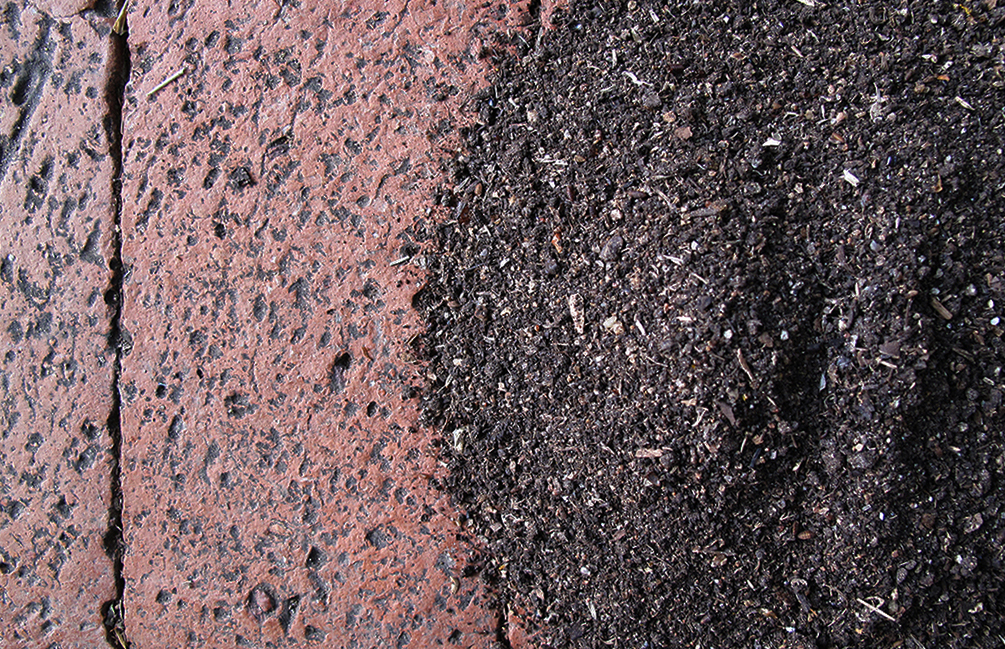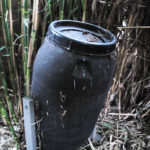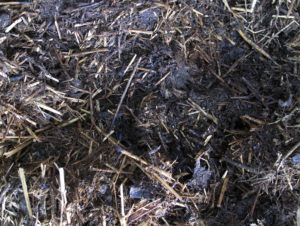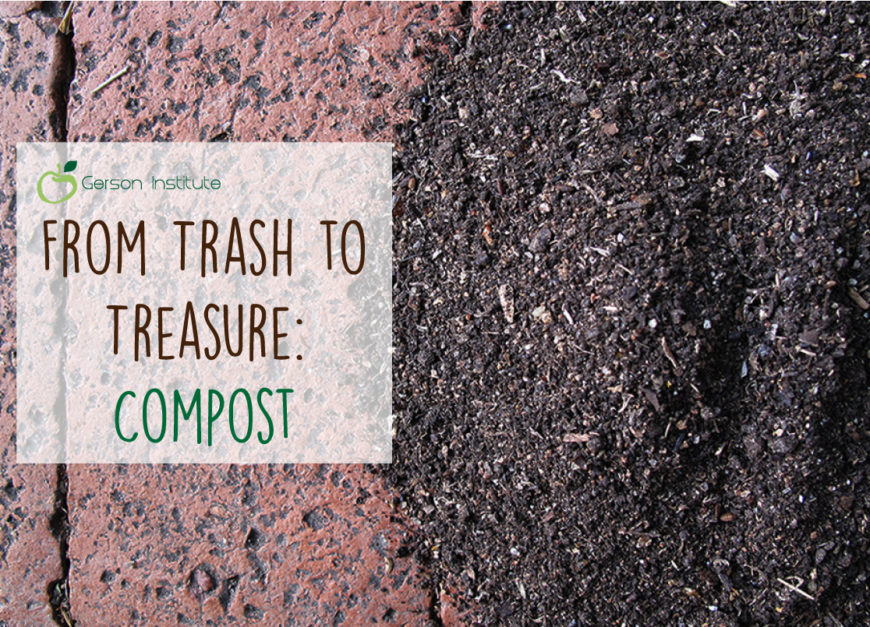
Throughout the Gerson Kitchen Video Series I mention the term “compost”. Usually, I use it in regards to food scraps, or what some may call waste. If you’re on the Gerson Therapy, or someone who happens to cook or juice regularly, you likely find yourself getting rid of quite a bit of produce each week, whether it be the rough ends of produce items, pieces that have gone bad, coffee grounds, or lots and lots of juice pulp. But these scraps certainly deserve to be treated better than waste, as they have the potential to become part of the healthiest soil you have ever seen.
The U.S. Environmental Protection Agency (“EPA”) estimates that “more food reaches landfills and incinerators than any other single material in our everyday trash, about 21 percent of the waste stream. Reducing food waste will help the United States address climate change, as 20 percent of total U.S. methane emissions come from landfills.” Food waste is a huge issue, now more than ever, and we have a big opportunity to help the problem, rather than contributing to it.
 These scraps should be helping you heal by replenishing your soil rather then being added to a landfill somewhere. So what exactly is compost, and how does it help YOU? Webster’s dictionary defines compost, the noun, as “a mixture that consists largely of decayed organic matter and is used for fertilizing and conditioning land”. In other words, compost is unused food and organic material broken down into fertile dirt. Compost is one of the most valuable resources we have because it not only contains essential nutrients that our plants need, but it allows soil to hold more moisture, in turn improving soil structure and preventing soil erosion.
These scraps should be helping you heal by replenishing your soil rather then being added to a landfill somewhere. So what exactly is compost, and how does it help YOU? Webster’s dictionary defines compost, the noun, as “a mixture that consists largely of decayed organic matter and is used for fertilizing and conditioning land”. In other words, compost is unused food and organic material broken down into fertile dirt. Compost is one of the most valuable resources we have because it not only contains essential nutrients that our plants need, but it allows soil to hold more moisture, in turn improving soil structure and preventing soil erosion.
So how do you actually turn your trash into treasure by composting? Follow these 6 easy steps!
Choose an Area
Pick a part of your yard, preferably on grass or soil, to designate as space for your compost. Make sure it’s not near anything combustible and that it’s not too close to the house (can attract bugs)

A compost tumbler
Choose a Container
Composting can be done:
- Simply in an open pile. Place sticks and twigs at the bottom to define the pile and help air flow through the bottom of your compost pile (at least 3 x 3 ft.)
- By purchasing a compost bin or tumbler from garden or hardware stores (even some big box hardware stores carry them)
- By building your own. Drill a few holes in the bottom and sides of a plastic storage bin.
Collect “Browns” & “Greens”
“Browns” consist of dry leaves, straw, dry hay, sawdust, woodchips from untreated wood, twigs, dried grass clippings, dried weeds without seeds, shredded paper napkins, and tissue paper. “Greens” consist of vegetables and fruit scraps (fresh, cooked or canned), tea leaves/bags, garden waste, fresh weeds without seeds, and fresh grass clippings. Don’t forget to collect all those used coffee grounds too!
**Items that should not be composted include: meat, fish, eggs (egg shells are ok!), dairy products, oily foods, bones, pet waste, weeds with mature seeds, plants infected with disease, plastic/petroleum products, metals or synthetic materials.
Use the Right Ratio
Compost piles need a certain ratio of carbon (“browns”) to nitrogen (“greens”) in order to heat up properly and attract the microorganisms that really supercharge the breakdown process. Typically this means 3 times as much “browns” as “greens”.
Combine “Browns” and “Greens”
Now that you have a designated space, a container, and your “browns” and “greens”, it’s time to stop tossing out produce and start saving them! We recommend a small tub or 5 gallon bucket to keep in your kitchen (you can get these online, at garden supply stores, nurseries, or hardware stores).
- Once your indoor bucket is full of “greens”, take it outside and dump it into your compost bin/pile.
- Then, simply cover with whatever “browns” you have around. It’s good practice to keep a separate pile of “browns” nearby for easy grabbing each time you dump your indoor bin.
- Add 3 times more “brown” items than “green” items, and ensure that the “brown” is covering the “green”. This will help prevent major smalls and also helps to deter pests.
Check Your Compost
We recommend turning or flipping your compost pile at least once every two weeks in order to make sure oxygen regularly reaches each part of the compost pile. Second, it is recommended that compost piles be kept moist, which means occasionally watering your pile during dry stretches.This process can be continued indefinitely, but over time a second compost bin/pile may be needed. This will allow the first bin to sit and break down while you work on filling the second bin.
As the old adage goes, “compost happens”. Regardless of your level of mastery of composting technique, a pile of food scraps mixed with some “browns” will inevitably compost into good soil; it just takes time! Your compost should appear to be dark, crumbly, earthy smelling dirt, usually filled with lots of worms!
 Plant seeds in finished compost and feed your current plants with the finished product by simply scattering handfuls of compost near the plant’s base. Give them a bit of water and sunlight, and soon you’ll be eating fruits and veggies grown in compost made from your (previously unwanted) food scraps – it’s pretty magical! Use this compost to amend areas of your yard lacking in fertility or nutrition.
Plant seeds in finished compost and feed your current plants with the finished product by simply scattering handfuls of compost near the plant’s base. Give them a bit of water and sunlight, and soon you’ll be eating fruits and veggies grown in compost made from your (previously unwanted) food scraps – it’s pretty magical! Use this compost to amend areas of your yard lacking in fertility or nutrition.
As Dr. Gerson said in his book, A Cancer Therapy: Results of 50 Cases, “the soil must be regarded as our external metabolism”, and he continues by saying “the soil must be cared for properly and must not be depleted or poisoned”.
Caring for and improving the health of our soil not only will help give life to healthier, stronger plants, but in turn will lead to healthier, stronger people.
References & Resources
https://www/epa.gov/recycle/composting-home
http://www.cawrecycles.org/composting/
Join Over 250,000 Gerson Fans!
![]() Educational articles like this are made possible with the help of your donations. Help us continue the legacy of Dr. Max Gerson, his daughter Charlotte Gerson, and the thousands who rely on the Gerson Institute for vital educational materials and training.
Educational articles like this are made possible with the help of your donations. Help us continue the legacy of Dr. Max Gerson, his daughter Charlotte Gerson, and the thousands who rely on the Gerson Institute for vital educational materials and training.
This article was originally published on April 20, 2018
Written by: Eric Freeman
Post by: Nicole Ferrer-Clement


